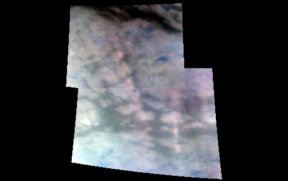Titan’s Massive Mountains
The Saturn-orbiting Cassini spacecraft has spied a chain of large mountains on Titan.
By Emily Sohn
Saturn’s moon Titan has long fascinated scientists with its thick atmosphere, liquid-filled lakes, textured landscape, and other Earth-like qualities.
New images now reveal the largest mountains yet discovered on Titan. The peaks are 1.5 kilometers (nearly a mile) high. The range is about 100 miles long. Titan itself has a diameter of 5,150 kilometers.
 |
|
A massive mountain range lies just south of Titan’s equator in this image taken by the Cassini spacecraft. |
| NASA/JPL/University of Arizona |
The Cassini spacecraft captured the images on Oct. 25, 2006. Cassini has been observing Saturn and its moons from orbit since 2004. On the day it spotted the tall mountains, the spacecraft flew within 12,000 kilometers (about 7,500 miles) of Titan.
Cassini detected the mountains in two ways. Infrared images showed the mountains’ shadows. Radar revealed their shapes.
Clouds surround the icy mountains, and many layers of organic material blanket them. Scientists think that some of these layers consist of stuff that has fallen out of the moon’s atmosphere as rain, dust, or smog.
Bright, white material tops the peaks. Astronomers suspect that this is snow made of methane. On Earth, such mountaintop snow would be water ice.
How the mountains formed is an open question. One possibility is that underground, tectonic forces pulled apart the outer crust of the moon. Such forces would have allowed material underneath to rise up and form hills.
This is how undersea ridges formed on Earth.
Another possibility is that Titan’s mountains rose as sections of the moon’s crust squeezed together.
“I don’t think we yet have a sufficiently global picture of Titan’s crust to make an assessment,” says Cassini researcher Jonathan Lunine of the University of Arizona in Tucson.
The October images came from Cassini’s 22nd flyby of Titan. The spacecraft will pass near the moon 23 more times in the next 2 years.—E. Sohn
Going Deeper:
Cowen, Ron. 2006. The big picture: Cassini spies Titan’s tall mountains. Science News 170(Dec. 23):405. Available at http://www.sciencenews.org/articles/20061223/fob6.asp .
Additional information about the discovery of massive mountains on Titan can be found at saturn.jpl.nasa.gov/news/press-release-details.cfm?newsID=709 (NASA).
Sohn, Emily. 2006. Lakes on Titan”. Science News for Kids (Aug. 23). Available at http://www.sciencenewsforkids.org/articles/20060823/Note2.asp .
______. 2005. Sounds of Titan. Science News for Kids (Feb. 16). Available at http://www.sciencenewsforkids.org/articles/20050216/Feature1.asp .
______. 2005. Unveiling Titan. Science News for Kids (Jan. 26). Available at http://www.sciencenewsforkids.org/articles/20050126/Note2.asp .
______. 2004. Ringing Saturn. Science News for Kids (July 28). Available at http://www.sciencenewsforkids.org/articles/20040728/Feature1.asp .
SciFiZone
http://www.sciencenewsforkids.org/articles/20041117/SciFiZone.asp







